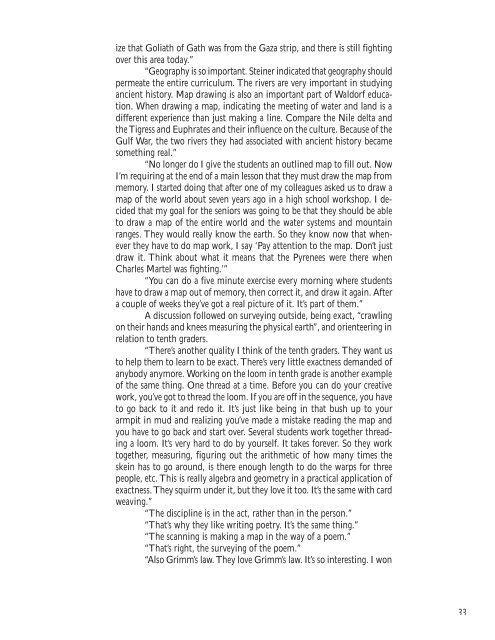Proceedings Colloquium on World History - Waldorf Research Institute
Proceedings Colloquium on World History - Waldorf Research Institute
Proceedings Colloquium on World History - Waldorf Research Institute
You also want an ePaper? Increase the reach of your titles
YUMPU automatically turns print PDFs into web optimized ePapers that Google loves.
ize that Goliath of Gath was from the Gaza strip, and there is still fighting<br />
over this area today.”<br />
“Geography is so important. Steiner indicated that geography should<br />
permeate the entire curriculum. The rivers are very important in studying<br />
ancient history. Map drawing is also an important part of <strong>Waldorf</strong> educati<strong>on</strong>.<br />
When drawing a map, indicating the meeting of water and land is a<br />
different experience than just making a line. Compare the Nile delta and<br />
the Tigress and Euphrates and their influence <strong>on</strong> the culture. Because of the<br />
Gulf War, the two rivers they had associated with ancient history became<br />
something real.”<br />
“No l<strong>on</strong>ger do I give the students an outlined map to fill out. Now<br />
I’m requiring at the end of a main less<strong>on</strong> that they must draw the map from<br />
memory. I started doing that after <strong>on</strong>e of my colleagues asked us to draw a<br />
map of the world about seven years ago in a high school workshop. I decided<br />
that my goal for the seniors was going to be that they should be able<br />
to draw a map of the entire world and the water systems and mountain<br />
ranges. They would really know the earth. So they know now that whenever<br />
they have to do map work, I say ‘Pay attenti<strong>on</strong> to the map. D<strong>on</strong>’t just<br />
draw it. Think about what it means that the Pyrenees were there when<br />
Charles Martel was fighting.’”<br />
“You can do a five minute exercise every morning where students<br />
have to draw a map out of memory, then correct it, and draw it again. After<br />
a couple of weeks they’ve got a real picture of it. It’s part of them.”<br />
A discussi<strong>on</strong> followed <strong>on</strong> surveying outside, being exact, “crawling<br />
<strong>on</strong> their hands and knees measuring the physical earth”, and orienteering in<br />
relati<strong>on</strong> to tenth graders.<br />
“There’s another quality I think of the tenth graders. They want us<br />
to help them to learn to be exact. There’s very little exactness demanded of<br />
anybody anymore. Working <strong>on</strong> the loom in tenth grade is another example<br />
of the same thing. One thread at a time. Before you can do your creative<br />
work, you’ve got to thread the loom. If you are off in the sequence, you have<br />
to go back to it and redo it. It’s just like being in that bush up to your<br />
armpit in mud and realizing you’ve made a mistake reading the map and<br />
you have to go back and start over. Several students work together threading<br />
a loom. It’s very hard to do by yourself. It takes forever. So they work<br />
together, measuring, figuring out the arithmetic of how many times the<br />
skein has to go around, is there enough length to do the warps for three<br />
people, etc. This is really algebra and geometry in a practical applicati<strong>on</strong> of<br />
exactness. They squirm under it, but they love it too. It’s the same with card<br />
weaving.”<br />
“The discipline is in the act, rather than in the pers<strong>on</strong>.”<br />
“That’s why they like writing poetry. It’s the same thing.”<br />
“The scanning is making a map in the way of a poem.”<br />
“That’s right, the surveying of the poem.”<br />
“Also Grimm’s law. They love Grimm’s law. It’s so interesting. I w<strong>on</strong><br />
33
















